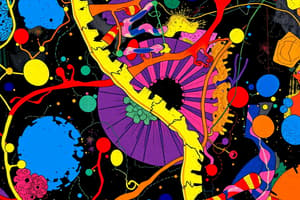Podcast
Questions and Answers
What are cells?
What are cells?
Structural units of all living things
Which of the following concepts are part of the Cell Theory? (Select all that apply)
Which of the following concepts are part of the Cell Theory? (Select all that apply)
- The activity of an organism is independent of its cells.
- A cell is the basic structural and functional unit of living organisms. (correct)
- All cells arise from previously existing cells. (correct)
- Cells are only found in multicellular organisms.
What are the three main parts of a cell?
What are the three main parts of a cell?
Plasma membrane, cytoplasm, nucleous
What is the function of the plasma membrane?
What is the function of the plasma membrane?
What is cytoplasm?
What is cytoplasm?
What does the nucleous do?
What does the nucleous do?
What is extracellular material?
What is extracellular material?
What is interstitial fluid?
What is interstitial fluid?
What is cell signaling?
What is cell signaling?
What does the Fluid Mosaic Model show?
What does the Fluid Mosaic Model show?
What are glycolipids?
What are glycolipids?
What are integral proteins?
What are integral proteins?
What is the difference between hydrophilic and hydrophobic?
What is the difference between hydrophilic and hydrophobic?
What is osmosis?
What is osmosis?
What is the primary function of the sodium-potassium pump?
What is the primary function of the sodium-potassium pump?
Define tonicity.
Define tonicity.
Which transport process includes the engulfing of large materials by the cell?
Which transport process includes the engulfing of large materials by the cell?
What is the role of ribosomes?
What is the role of ribosomes?
What are mitochondria known for?
What are mitochondria known for?
What does resting membrane potential refer to?
What does resting membrane potential refer to?
Flashcards are hidden until you start studying
Study Notes
Cells: Basic Units of Life
- Cells are the structural units of all living organisms.
- The Cell Theory includes:
- Cells are the basic unit of life.
- Organism activities depend on individual and combined cell functions.
- Complementary structure and function principle.
- Cells arise only from pre-existing cells.
Cell Structure Components
- Main parts of a cell:
- Plasma membrane
- Cytoplasm
- Nucleus
- Plasma membrane serves as a selectively permeable barrier for the cell.
Cytoplasm and Organelles
- Cytoplasm is the fluid within the cell that contains organelles, which perform specific functions.
- Nucleus controls cellular activities and is located at the cell's center.
Extracellular Environment
- Extracellular materials contribute to body mass but lie outside cells.
- Interstitial fluid surrounds cells, providing various nutrients.
Cell Signaling and Membrane Structure
- Cell signaling involves interactions of membrane proteins with chemical messengers.
- The Fluid Mosaic Model describes the plasma membrane as a bilayer with lipids and proteins.
Membrane Composition
- Lipid bilayer includes phospholipids, glycolipids, and cholesterol.
- Hydrophilic parts are water-attracting; hydrophobic parts repel water.
- Glycocalyx is a carbohydrate-rich area on the membrane surface formed by glycoproteins and glycolipids.
Cell Junctions
- Tight junctions create impermeable barriers between cells.
- Desmosomes anchor adjacent cells, preventing separation.
- Gap junctions allow communication between adjacent cells, facilitated by connexons.
Transport Mechanisms
- Passive processes enable substances to cross membranes without energy input.
- Active processes require cellular energy (ATP) to transport substances.
- Key transport types:
- Diffusion moves substances from high to low concentration.
- Osmosis refers to water movement across membranes.
Solutions and Tonicity
- Isotonic solutions have equal solute concentrations inside and outside cells.
- Hypertonic solutions cause cells to lose water and shrink.
- Hypotonic solutions lead to water gain and cell swelling.
Active Transport
- Requires carrier proteins to move substances against concentration gradients.
- The sodium-potassium pump is an example that maintains ion concentrations inside cells.
Vesicular Transport
- Vesicular transport uses membrane-bound sacs (vesicles) to move large particles.
- Phagocytosis engulfs large particles, while pinocytosis involves fluid intake.
- Receptor-mediated endocytosis captures specific extracellular materials.
Cytoplasmic Organelles
- Mitochondria are the powerhouses of cells, producing ATP.
- Ribosomes synthesize proteins, forming either free or membrane-bound types on the rough endoplasmic reticulum (ER).
- The Golgi apparatus modifies and packages proteins for secretion.
Structural Elements of the Cell
- Cytoskeleton supports cellular structure and movement, composed of microfilaments, intermediate filaments, and microtubules.
- Centrosomes organize microtubules and contain centrioles, which assist in cell division.
Cell Surface Structures
- Cilia and flagella are projections that assist in movement.
- Microvilli enhance surface area for absorption.
Nucleus and its Functions
- The nucleus houses genes and regulates cellular activities, with multinucleate cells having multiple nuclei, while anucleate cells cannot reproduce.
Additional Notes
- Membrane potential refers to voltage differences across membranes, crucial for cell signaling.
- Ligands bind to membrane receptors to trigger cellular responses.
Studying That Suits You
Use AI to generate personalized quizzes and flashcards to suit your learning preferences.




